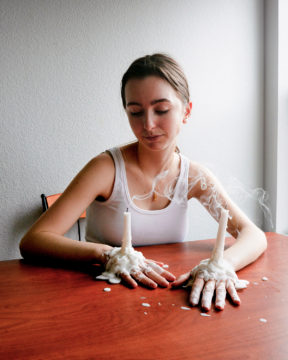Cat Lachowskyj in Lens Culture:
 Standing in the middle of a room previously inhabited by a now-absent figure can conjure an eerily potent atmosphere, traceable through sensations rather than words. Perhaps it’s because so much of what shapes the edges of any individual’s persona resides within the colors they prefer, their cooking and cleaning smells, or the sounds they regularly hear emanating from the pipes in their walls or a creak in their floorboards. When a person’s body exits their habitat, all the things that previously swirled in and around their tangible body remain, suspended in the air in a thick, viscous hum. These remnants permeate the objects the person leaves behind, too, charged with energy, appearing as sentient creatures rather than a lifeless pile of stuff.
Standing in the middle of a room previously inhabited by a now-absent figure can conjure an eerily potent atmosphere, traceable through sensations rather than words. Perhaps it’s because so much of what shapes the edges of any individual’s persona resides within the colors they prefer, their cooking and cleaning smells, or the sounds they regularly hear emanating from the pipes in their walls or a creak in their floorboards. When a person’s body exits their habitat, all the things that previously swirled in and around their tangible body remain, suspended in the air in a thick, viscous hum. These remnants permeate the objects the person leaves behind, too, charged with energy, appearing as sentient creatures rather than a lifeless pile of stuff.
When photographer Hannah Altman’s grandmother passed away in 2017, she left an interesting collection of objects in her home, some detailing her life, some used for Jewish ritual, and some broken and incomplete. The objects felt like a composite of her grandmother’s life, and as a photographer, Altman decided to document them with her camera. “I started photographing the Judaica in her collection, thinking about how objects are used and what stories they tell,” she explains. After establishing familiarity with the remnants, Altman shifted into world-making beyond the isolated documentation of trinkets, initiating a ripple effect in her own understanding of her new visual world. She reflects, “I photographed the Jewish objects, and then Jewish rituals, and then Jewish folklore, and it became clear to me that this idea of storytelling through Judaica extended beyond my immediate bloodline, into the collective Jewish community, which is deeply shaped by customs that are retold and retranslated over time.”
More here.
